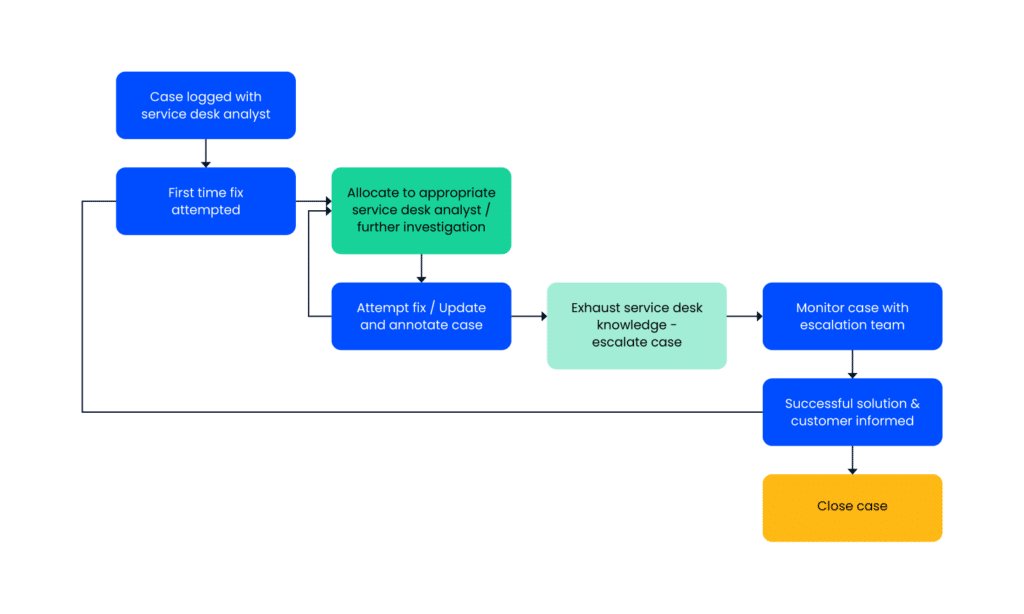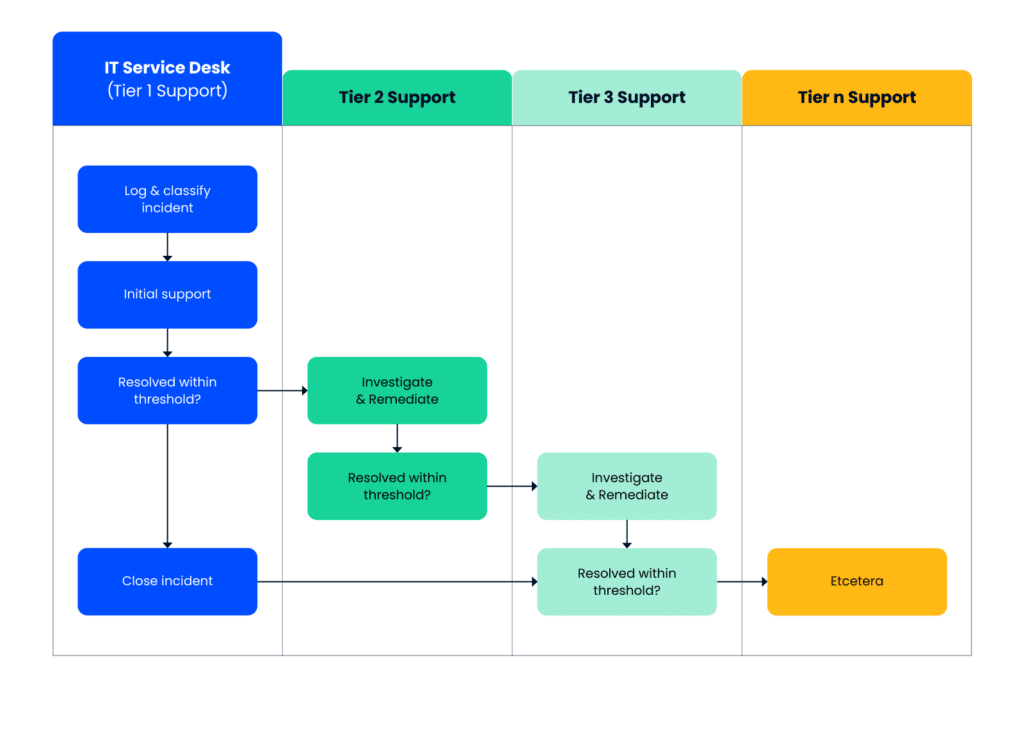The value delivery function of each business is a series of either manual workflows or automated workflows strung together to deliver outcomes to a customer or stakeholder. Without workflows, you have no way of getting work done, let alone delivering it to a client or stakeholder.
Managing projects effectively requires organization and a well-defined workflow.
What Is A Workflow in Project Management?
A workflow is a repeatable series of steps or activities that are necessary to complete a task. For example, when creating a new website, the workflow process may involve designing the layout, writing the code, testing the site, and launching it live.
By using a workflow, project managers can help to keep projects on track and ensure that all tasks are completed as efficiently as possible.
Workflows are often visualized in the format of a flowchart, either showing the process steps each work item will go through to be considered done, or what the process looks like at a more macro-level, showing the stages in the process of task completion or project completion overall.
It's important not to confuse workflow diagrams and flowcharts with other project management visualization tools:
- Gantt charts show the specific tasks and activities that will be completed throughout the project, when they will be completed, and who is working on them. Workflows are higher-level, focusing on phases or stages rather than individual tasks.
- Critical paths show the shortest possible duration of the project by taking into account specific tasks and their dependencies. Workflows don't usually include timings or durations for different stages.
- PERT diagrams also take into account specific tasks and dependencies, but it's more focused on milestones than specific activities. While your workflows will likely contain some indications of milestones, they won't account for dependencies specifically (only the sequence of steps).
The Evolution of Workflows
The origins of what we think of today as workflows can be traced back to Frederick Taylor and Henry Gantt (the namesake of the Gantt chart). Both pioneers in scientific management and work standardization, their work involved applying scientific principles to improve worker productivity.
Taylor's work gave rise to a host of new ideas about how to manage workers, organize the flow of work, and create more productive employees and teams.
In the 1980s and 1990s, companies began using computers in offices, which allowed repetitive tasks and workflows and process to be automated, and business software like enterprise resource planning tools (ERPs) and customer relationship management software (CRMs) gained popularity.
Workflows are now inseparable from the workflow management software that power them, and more recent advancements, such as the integration of machine learning and artificial intelligence for use in project management applications, cloud computing and storage, and process analysis software, give organizations the ability to continually refine and adapt their processes to find the most efficient and productive ways of working.
Examples of Different Types of Workflows
There are a few different types of workflows, but generally, you will either be building a workflow for a process or a project.
Workflow use cases and examples of workflows that project managers will follow include:
- Getting a project request from a project sponsor, and getting the project started
- Defining requirements, developing to those requirements, testing, and launching a product or service
- The project management life cycle: think initiation, planning, execution, monitor & control, closure.
Project managers may also create workflows for processes that their team carries out, such as customer experience and support workflows, onboarding workflows, procurement workflows, business operations workflows, or digital workflows for creating and approving digital assets.
Here's a detailed example of a support delivery workflow.

- The complaint or support ticket is logged with the service desk analyst.
- A fix is attempted. If it's successful, skip to step seven.
- If it's not successful, allocate the ticket to the appropriate service desk analyst for further investigation.
- Attempt another fix and update and annotate the ticket. Repeat as needed.
- Exhaust the service desk knowledge and escalate the ticket.
- Monitor the ticket with the escalation team.
- Find a successful solution and inform the customer.
- Close the ticket.
Workflows can be documented and communicated at many different levels.
The below workflow shows a larger-scope of work and a higher-level process for support delivery, which may include smaller processes (which should also be documented, of course).

This workflow diagram uses swimlanes to show which team handles various parts of the process so ownership at each workflow step is clear. Swimlanes are not a required workflow diagram element, but they can be very helpful when mapping out a complex process that spans many teams or areas of responsibility.
Double-clicking in on the first swimlane, we uncover a lower-level workflow describing what happens in much more detail than we can observe in the higher-level process.

High-level workflow diagrams are best used with larger strategic groups to help understand project life cycle or high-level progress where more detailed workflow diagrams are often used with the team that will be completing or trying to iterate the process.
How To Create An Effective Workflow
Here is step-by-step guide to create an effective workflow:
- Start with sticky notes. Make a sticky note for each thing needing to be done or stage of the project, and move them into a thoughtful sequence of tasks.
- Consult with the team. Talk to the people who are actually carrying out the steps in the workflow. Find out if there's anything missing, if there's a step in the wrong order, or if there are other considerations that you've missed.
- Map out the workflow. This is normally easiest to do in flowchart software, workflow diagram software, or mind mapping software. Write down the steps in the process and leave space in between the steps.
- Draw squares around each step in the activity and show how you move on to the next step with arrows.
- Identify bottlenecks, redundancies, and dependencies. Note these with specific symbols or colors (and include a legend).
- Define roles and responsibilities. You won't be assigning people to specific phases or tasks, but you should know what roles will be involved in the process. For example, in a project initiation workflow, the project manager is responsible for setting up a kickoff call, and the client must approve the project plan.
- File it in the appropriate place and make sure everyone has access. Not only is it important for the team to be able to refer back to as they're completing work, but this is also important for employee onboarding and training new team members and new employees.
Best Practices For Creating Workflows
As you're creating your project workflows, here are some best practices to keep in mind.
- Have a clear objective. Make sure your workflow has a purpose and is something the team needs. No one will follow a process that doesn't offer any value to them or the project.
- Establish a feedback loop. Keep getting feedback from the team and anyone else using the workflow. Find out what's working and what's not, and adjust the workflow as needed.
- Make use of software and process automation tools. Workflow automation software and other process workflow software tools are made to create, automate, and optimize workflows, in order to reduce human error and inefficiencies.
- Establish how you'll measure success. Determine which KPIs and metrics you'll use in decision-making about whether your workflow is being used successfully. This data is a good indicator of whether you need to adjust it or not.
- Consider scalability. Build scalability into your workflows and determine how you'll adapt as the team and the organization grows. Consider whether you'll need to add more steps in the process, whether more or less people will need to be involved, and whether you'll need to build in more approval phases or checkpoints.
- Iterate. Continuously update your workflows as you get feedback, as you scale, and as you use metrics to determine if they are working. Iterating doesn't mean your workflows were wrong, just that they can always be improved.
What Is The Difference Between Workflows & Processes?
In business, the terms ‘workflow’ and ‘process’ are often used interchangeably. However, there is a subtle but important distinction between the two.
A workflow is a set of steps that need to be followed to complete a task.
Processes (including business processes), on the other hand, are designed to be followed rigidly in order to achieve a specific outcome.
Workflows are typically more flexible and less formal than processes, as they can be adapted to changing circumstances. They don't necessarily require extensive documentation or approval from multiple stakeholders.
As a result, workflows are often faster and easier to implement than processes. However, processes can be more efficient in certain situations, such as when there is a need for strict compliance with regulations.
Automating Workflows with Tools & Software
Workflows and the workflow management systems that govern them are often one and the same. Aside from some of the management tools I mentioned above, there are a few more to consider:
- Business process management (BPM) tools are useful for organizing, managing, and updating your most important business processes, as well as carrying out process improvement and process mapping.
- Workflow apps are useful for moments when you need to make a process change but you don't have access to your desktop.
If you give these a try, you are sure to find a workflow tool that fits your needs and unique style.
Need expert help selecting the right Workflow Management Software?
If you’re struggling to choose the right software, let us help you. Just share your needs in the form below and you’ll get free access to our dedicated software advisors who match and connect you with the best vendors for your needs.
What's Next?
There's always more to learn about improving your business workflows and reducing inefficiencies. Connect with your peers and join the conversation in Slack with 100's of other digital project managers with DPM Membership! You'll also get access to 100+ templates, samples, and examples for project documents like project estimates and budgets, project plans, and more.



